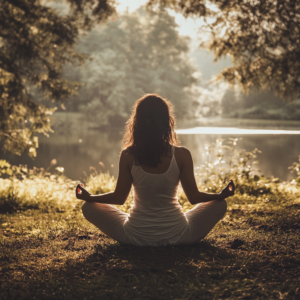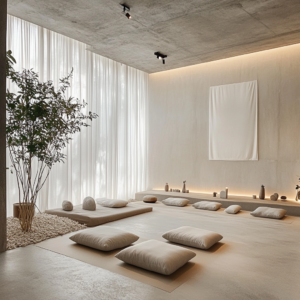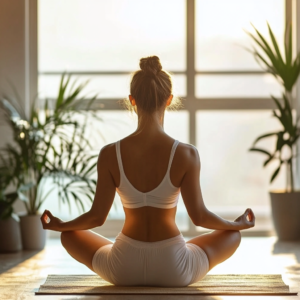1. Introduction
The Role of Breath is the foundation of both meditation and yoga, serving as a powerful tool to clear the mind, reduce stress, and enhance overall wellbeing. In today’s fast-paced society, our breath is often taken for granted while our minds are overwhelmed by constant distractions and pressures. This guide explores essential techniques that harness the power of controlled breathing to foster mental clarity and emotional balance. By understanding and practicing these methods, you can create a daily routine that not only grounds you in the present moment but also rejuvenates both body and mind. For further inspiration on holistic practices, check out our article on Mindful Living: 7 Daily Habits to Boost Wellbeing.

2. Foundations of Breath Control
Building an effective breathwork practice starts with understanding the underlying principles that connect the act of breathing to our overall health.
The Connection Between Breath and Mind
Our breath is the bridge between our physical body and our mental state. Focusing on deep, controlled breathing helps quiet the mind and create a sense of inner calm. This fundamental idea is at the heart of The Role of Breath and sets the stage for all further practices.
Historical Perspectives on Breathwork
Ancient traditions have long recognized the power of the breath. Techniques such as pranayama in yoga were developed to cultivate a harmonious balance between body and mind. Modern research now supports these ancient practices, affirming that learning to control one’s breath can lead to profound benefits—a core concept of The Role of Breath.
The Importance of Awareness
Awareness of the breath is essential to unlocking its potential. By paying attention to each inhalation and exhalation, you can gradually reduce mental clutter and stress. This mindful approach is critical to fully experiencing The Role of Breath.
3. Scientific Insights into Breathwork
Modern science has shed light on the remarkable benefits of controlled breathing, offering concrete evidence to support traditional practices.
Neurobiological Effects
Studies using imaging techniques like fMRI and EEG reveal that regular breathwork increases grey matter in areas of the brain responsible for attention and emotional regulation. These structural changes highlight how The Role of Breath can literally reshape the brain for enhanced mental clarity.
Hormonal Regulation
Controlled breathing has been shown to reduce cortisol levels—the hormone associated with stress. Lower cortisol levels lead to improved mood, better sleep, and a stronger immune system, underscoring the benefits of The Role of Breath in overall health.
Enhancing Neural Connectivity
Research indicates that focused breathing can improve neural connectivity between the prefrontal cortex and other brain regions. This connectivity supports enhanced cognitive function and is a scientific testament to The Role of Breath as a tool for achieving a clear mind.
Additional Scientific Perspectives
For more detailed studies and scientific findings on breathwork, consider exploring the resources available at the National Center for Complementary and Integrative Health.
4. Psychological and Emotional Benefits
Beyond the physical, mindful breathing techniques offer substantial psychological advantages that contribute to emotional stability and cognitive clarity.
Reducing Anxiety and Stress
Consistent practice of controlled breathing helps lower anxiety by calming the nervous system. This reduction in stress not only improves your mood but also enhances overall mental clarity—a key benefit of The Role of Breath.
Enhancing Focus and Concentration
By directing your attention solely to your breath, you train your mind to remain present. This improved focus translates to better performance in everyday tasks and increased productivity.
Building Emotional Resilience
Mindful breathwork allows you to observe your emotions without being overwhelmed by them. With time, this practice builds emotional resilience and provides the tools necessary to navigate life’s challenges. This psychological strength is a direct outcome of The Role of Breath in everyday life.
5. Establishing a Daily Breathwork Practice
A consistent daily practice is essential to fully unlock the benefits of controlled breathing.
Creating Your Dedicated Space
Select a quiet, comfortable area in your home where you can practice without interruption. This dedicated space not only minimizes distractions but also serves as a visual reminder to practice—embodying The Role of Breath in your environment.
Setting a Regular Schedule
Consistency is crucial. Dedicate a specific time each day for your breathwork practice, even if it starts with just 10–15 minutes. Over time, this regular routine will help you build a habit that integrates The Role of Breath seamlessly into your daily life.
Guided Sessions for Beginners
For those new to the practice, guided meditation sessions can provide clear instructions and help focus on proper breathing techniques. These sessions are a practical way to initiate your journey toward The Role of Breath.
For additional guidance on building a consistent routine, check out our article on Mindful Living: 7 Daily Habits to Boost Wellbeing.

6. Practical Techniques for Mindful Breathing
In this section, we explore specific techniques designed to enhance the power of your breath for improved focus and stress relief.
Diaphragmatic Breathing
Diaphragmatic or belly breathing is a foundational exercise that involves deep inhalations through the nose, allowing your abdomen to expand, followed by slow exhalations through the mouth. This method increases oxygen flow and calms the nervous system, effectively demonstrating The Role of Breath in fostering relaxation.
Alternate Nostril Breathing
Alternate nostril breathing (Nadi Shodhana) helps balance the left and right hemispheres of the brain. By consciously alternating your breath between nostrils, you achieve a state of mental equilibrium that embodies The Role of Breath. This technique is widely regarded for its ability to reduce anxiety and enhance clarity.
Box Breathing
Box breathing is a structured technique involving equal counts for inhalation, holding, exhalation, and pausing. This rhythmic practice not only stabilizes the breath but also focuses the mind, reinforcing the principles of The Role of Breath.
Guided Visualization
Visualization exercises complement breathwork by encouraging you to imagine peaceful scenarios or successful outcomes. As you breathe deeply, envision a calm landscape or visualize releasing tension with each exhale. This method deepens the experience of The Role of Breath and further clears mental clutter.
YouTube Demonstrations
For practical demonstrations of these techniques, numerous guided sessions are available on YouTube. For instance, Yoga with Adriene offers sessions that integrate breathwork into a cohesive practice, making it easier to master The Role of Breath.

7. Integrating Breathwork into Yoga Practices
Breathwork is not only a standalone practice; it is an integral part of yoga that enhances the effectiveness of physical postures and meditative focus.
Synchronizing Breath with Movement
In yoga, synchronizing breath with movement is essential. Flow sequences like Vinyasa require you to coordinate each movement with your breath, creating a meditative rhythm that enhances physical balance and mental focus. This practice epitomizes The Role of Breath by uniting body and mind in a seamless flow.
Asanas That Emphasize Breath Control
Certain yoga postures, such as the Tree Pose, Warrior II, and Bridge Pose, inherently demand focused breathing. These asanas improve physical stability and cultivate mental concentration, reinforcing the benefits of The Role of Breath in achieving a balanced practice.
Transitioning from Yoga to Meditation
After completing a yoga session, transitioning into a seated meditation while maintaining awareness of your breath can deepen the calming effects. This integrated practice not only solidifies your experience of The Role of Breath but also sets a positive tone for the rest of your day.
Transform your Yoga practice with the Absolute Yoga Course!Discover how to unite body, mind and spirit in a single online program, led by a renowned instructor. In Absolute Yoga, you will:
- Learn basic and advanced postures with practical step-by-step classes;
- Master meditation techniques to reduce stress and increase focus;
- Immerse yourself in the philosophy and history of yoga, understanding its roots and applications in everyday life;
- Develop your physical, mental and emotional well-being, regardless of your level of experience.
8. Leveraging Technology and Resources
Modern technology provides an array of tools to support and enhance your breathwork practice.
Meditation and Yoga Apps
Digital platforms such as Calm, Insight Timer, and Headspace offer guided sessions, daily reminders, and progress tracking features that make it easier to maintain a consistent practice. These apps are invaluable for those committed to integrating The Role of Breath into their busy schedules.
Online Educational Platforms
Websites like Mindful.org and Yoga Journal offer comprehensive resources, including articles, videos, and expert advice on meditation and breathwork techniques. Engaging with these platforms can help deepen your understanding and support your journey toward The Role of Breath.
YouTube as a Learning Hub
YouTube is a vast repository of guided meditation and yoga sessions focused on breathwork. Channels such as The Honest Guys provide immersive, practical sessions that help refine your technique and encourage the continuous practice of The Role of Breath.
9. Overcoming Challenges and Sustaining Your Practice
The journey toward mastering your breath is not without obstacles. However, recognizing and addressing these challenges is key to long-term success.
Managing Distractions
It is natural for your mind to wander during breathwork sessions. When distractions arise, gently redirect your focus back to your breath. This practice is essential for realizing The Role of Breath and strengthening your mental discipline.
Adapting to Physical Discomfort
For some, maintaining proper posture or executing certain breathing techniques can be challenging. Experiment with variations—using props like cushions or modifying your position—until you find a method that suits your body. Overcoming these physical challenges is vital for consistently practicing The Role of Breath.
Cultivating Patience and Persistence
Progress in mastering breathwork is gradual. It is important to maintain a patient, non-judgmental attitude toward yourself. Each session, regardless of its duration, contributes to building the mental resilience that defines The Role of Breath. Celebrate small victories along the way, and allow your practice to evolve naturally.
For additional strategies on overcoming common meditation challenges, visit Mindful.org.
10. Frequently Asked Questions (FAQ)
Q1: What is the core idea behind “The Role of Breath: Essential Techniques in Meditation and Yoga”?
The article explains that controlled, mindful breathing is fundamental for clearing the mind, reducing stress, and fostering a balanced mind-body connection.
Q2: How does mindful breathing enhance overall wellbeing?
Mindful breathing clears mental clutter, improves focus, and lowers stress hormones, leading to enhanced cognitive and physical health.
Q3: What are the primary techniques recommended for effective breathwork?
Techniques such as diaphragmatic breathing, alternate nostril breathing, box breathing, and guided visualization are highlighted as effective methods for achieving a clear, calm mind.
Q4: Can these breathwork techniques be integrated into both meditation and yoga practices?
Yes, these techniques are versatile and can be seamlessly incorporated into yoga flows as well as standalone meditation sessions.
Q5: How can a regular breathwork practice benefit my daily life?
Regular practice improves concentration, reduces anxiety, and promotes emotional resilience, enabling you to face daily challenges with clarity and calm.
Q6: What are the psychological benefits of mindful breathing?
Mindful breathing enhances emotional regulation, reduces stress and anxiety, and fosters a positive, resilient mindset.
Q7: How should beginners start their breathwork practice?
Beginners are encouraged to start with short, guided sessions in a quiet space and gradually build up their practice to experience lasting benefits.
Q8: Which digital resources can help me learn more about breathwork?
Reputable resources include meditation apps like Headspace and Insight Timer, as well as YouTube channels such as The Honest Guys.
Q9: How can I integrate breathwork into my busy schedule?
Establish a regular routine, create a dedicated space for practice, and use digital tools and online resources to help maintain consistency.
Q10: How can I monitor the progress of my breathwork practice?
Keeping a journal or using tracking apps to record changes in focus, stress levels, and overall wellbeing can help you gauge your progress.
11. Conclusion
In conclusion, this comprehensive guide has explored how mastering the art of controlled breathing can profoundly impact both your mental clarity and overall wellbeing. By integrating the techniques outlined above into your daily routine, you can reduce stress, enhance focus, and foster a balanced state of mind that supports both meditation and yoga. Embrace the practice with patience and persistence, and allow your dedicated breathwork sessions to pave the way for a healthier, more resilient life. The insights shared here are designed to empower you to continuously harness The Role of Breath and transform everyday challenges into opportunities for growth.
Final Reflections
Every mindful breath you take is a step toward a clearer, more focused life. Continue to explore, adapt, and refine your practice. With consistent effort, you will unlock the full potential of your breath, experiencing not only improved mental clarity but also a deeper sense of inner peace and balance.
Thank you for reading The Role of Breath: Essential Techniques in Meditation and Yoga. May your practice bring you clarity, reduce stress, and enhance your overall wellbeing.